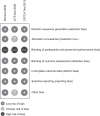Tinzaparin for Long-Term Treatment of Venous Thromboembolism in Patients With Cancer: A Systematic Review and Meta-Analysis
- PMID: 28288527
- PMCID: PMC6714676
- DOI: 10.1177/1076029617696581
Tinzaparin for Long-Term Treatment of Venous Thromboembolism in Patients With Cancer: A Systematic Review and Meta-Analysis
Abstract
Patients with cancer are at increased risk of recurrent venous thromboembolism (VTE) and bleeding. Thus, long-term treatment with anticoagulants for secondary prevention is challenging. The objective of this review was to evaluate current evidence on the safety and efficacy of tinzaparin compared with other anticoagulants for long-term VTE treatment in patients with cancer. Based on a preregistered protocol, we identified randomized controlled trials (RCTs) comparing long-term tinzaparin (therapeutic dose: 175 IU/kg) versus other anticoagulants for at least 3 months after an acute episode of VTE that included adult patients with underlying malignancy. We extracted predefined, clinically relevant outcomes of patients with cancer and, using standard methodology, pooled available data and assessed risk of bias and quality of evidence for each study. Three open-label RCTs evaluating 1169 patients with cancer were included in the analysis. Tinzaparin was associated with a significantly lower risk of recurrent VTE at the end of treatment (relative risk [RR], [95% confidence interval] 0.67 [0.46-0.99]) and at longest follow-up (RR: 0.58 [0.39-0.88]) and showed a lower risk of clinically relevant non-major bleeding at the end of treatment (RR: 0.71 [0.51-1.00]). No significant between-treatment differences were found for all-cause mortality (RR: 1.09 [0.91-1.30]) or fatal and non-fatal major bleeding events (RR: 1.06 [0.56-1.99]). The overall quality of evidence was deemed moderate, mainly due to small sample size in 2 of the studies and limited number of events in the meta-analyses. In conclusion, both short- and long-term treatments with tinzaparin were found to be superior to vitamin K antagonists for avoiding recurrences of VTE.
Keywords: anticoagulant; malignancy; tinzaparin; venous thromboembolism.
Conflict of interest statement
Figures





Similar articles
-
Anticoagulation for the initial treatment of venous thromboembolism in people with cancer.Cochrane Database Syst Rev. 2018 Jan 24;1(1):CD006649. doi: 10.1002/14651858.CD006649.pub7. Cochrane Database Syst Rev. 2018. Update in: Cochrane Database Syst Rev. 2021 Dec 8;12:CD006649. doi: 10.1002/14651858.CD006649.pub8. PMID: 29363105 Free PMC article. Updated.
-
Anticoagulation for the long-term treatment of venous thromboembolism in people with cancer.Cochrane Database Syst Rev. 2018 Jun 19;6(6):CD006650. doi: 10.1002/14651858.CD006650.pub5. Cochrane Database Syst Rev. 2018. PMID: 29920657 Free PMC article.
-
Anticoagulation for the initial treatment of venous thromboembolism in patients with cancer.Cochrane Database Syst Rev. 2011 Feb 16;(2):CD006649. doi: 10.1002/14651858.CD006649.pub3. Cochrane Database Syst Rev. 2011. Update in: Cochrane Database Syst Rev. 2011 Apr 13;(4):CD006649. doi: 10.1002/14651858.CD006649.pub4. PMID: 21328285 Updated.
-
Anticoagulation for the initial treatment of venous thromboembolism in patients with cancer.Cochrane Database Syst Rev. 2014 Jun 19;(6):CD006649. doi: 10.1002/14651858.CD006649.pub6. Cochrane Database Syst Rev. 2014. Update in: Cochrane Database Syst Rev. 2018 Jan 24;1:CD006649. doi: 10.1002/14651858.CD006649.pub7. PMID: 24945634 Updated.
-
Anticoagulation for the initial treatment of venous thromboembolism in patients with cancer.Cochrane Database Syst Rev. 2011 Jun 15;(6):CD006649. doi: 10.1002/14651858.CD006649.pub5. Cochrane Database Syst Rev. 2011. Update in: Cochrane Database Syst Rev. 2014 Jun 19;(6):CD006649. doi: 10.1002/14651858.CD006649.pub6. PMID: 21678360 Updated.
Cited by
-
Cancer-Associated Thrombosis: Not All Low-Molecular-Weight Heparins Are the Same, Focus on Tinzaparin, A Narrative Review.Int J Clin Pract. 2022 Jul 19;2022:2582923. doi: 10.1155/2022/2582923. eCollection 2022. Int J Clin Pract. 2022. PMID: 35936060 Free PMC article. Review.
-
The Role of Injectables in the Treatment and Prevention of Cancer-Associated Thrombosis.Cancers (Basel). 2023 Sep 20;15(18):4640. doi: 10.3390/cancers15184640. Cancers (Basel). 2023. PMID: 37760609 Free PMC article. Review.
-
A potential role of gut microbiota in stroke: mechanisms, therapeutic strategies and future prospective.Psychopharmacology (Berl). 2024 Dec;241(12):2409-2430. doi: 10.1007/s00213-024-06708-4. Epub 2024 Oct 27. Psychopharmacology (Berl). 2024. PMID: 39463207 Review.
-
Tinzaparin-a review of its molecular profile, pharmacology, special properties, and clinical uses.Eur J Clin Pharmacol. 2022 Oct;78(10):1555-1565. doi: 10.1007/s00228-022-03365-4. Epub 2022 Jul 23. Eur J Clin Pharmacol. 2022. PMID: 35871241 Free PMC article. Review.
References
-
- Franchini M, Montagnana M, Favaloro EJ, Lippi G. The bidirectional relationship of cancer and hemostasis and the potential role of anticoagulant therapy in moderating thrombosis and cancer spread. Semin Thromb Hemost. 2009;35(7):644–653. - PubMed
-
- Pabinger I, Posch F. Flamethrowers: blood cells and cancer thrombosis risk. Hematol Am Soc Hematol Educ Program. 2014;2014(1):410–417. - PubMed
-
- Wun T, White RH. Venous thromboembolism (VTE) in patients with cancer: epidemiology and risk factors. Cancer Invest. 2009;27(suppl 1):63–74. - PubMed
-
- Louzada ML, Majeed H, Dao V, Wells PS. Risk of recurrent venous thromboembolism according to malignancy characteristics in patients with cancer-associated thrombosis: a systematic review of observational and intervention studies. Blood Coagul Fibrinolysis. 2011;22(2):86–91. - PubMed
Publication types
MeSH terms
Substances
LinkOut - more resources
Full Text Sources
Other Literature Sources

